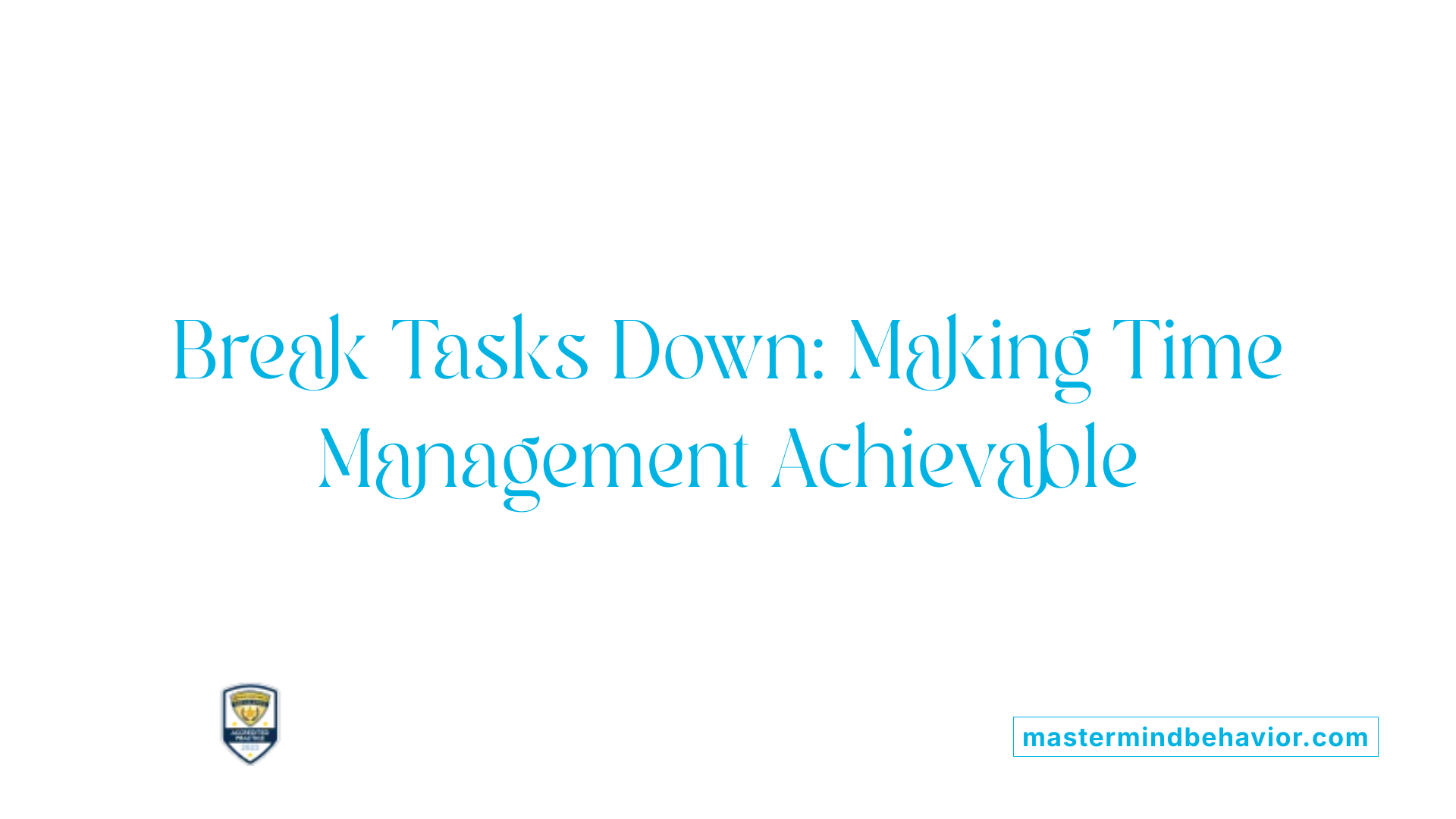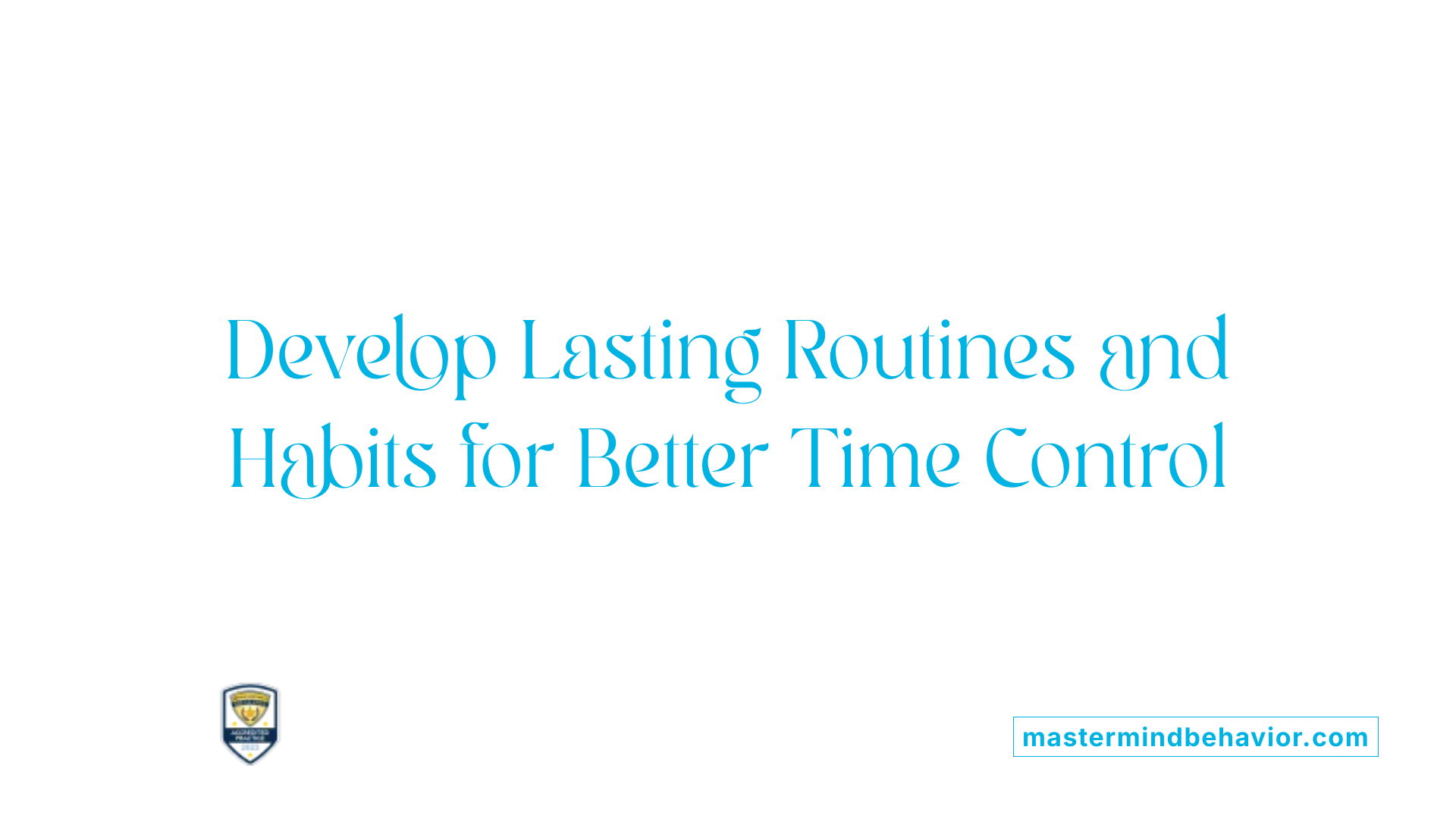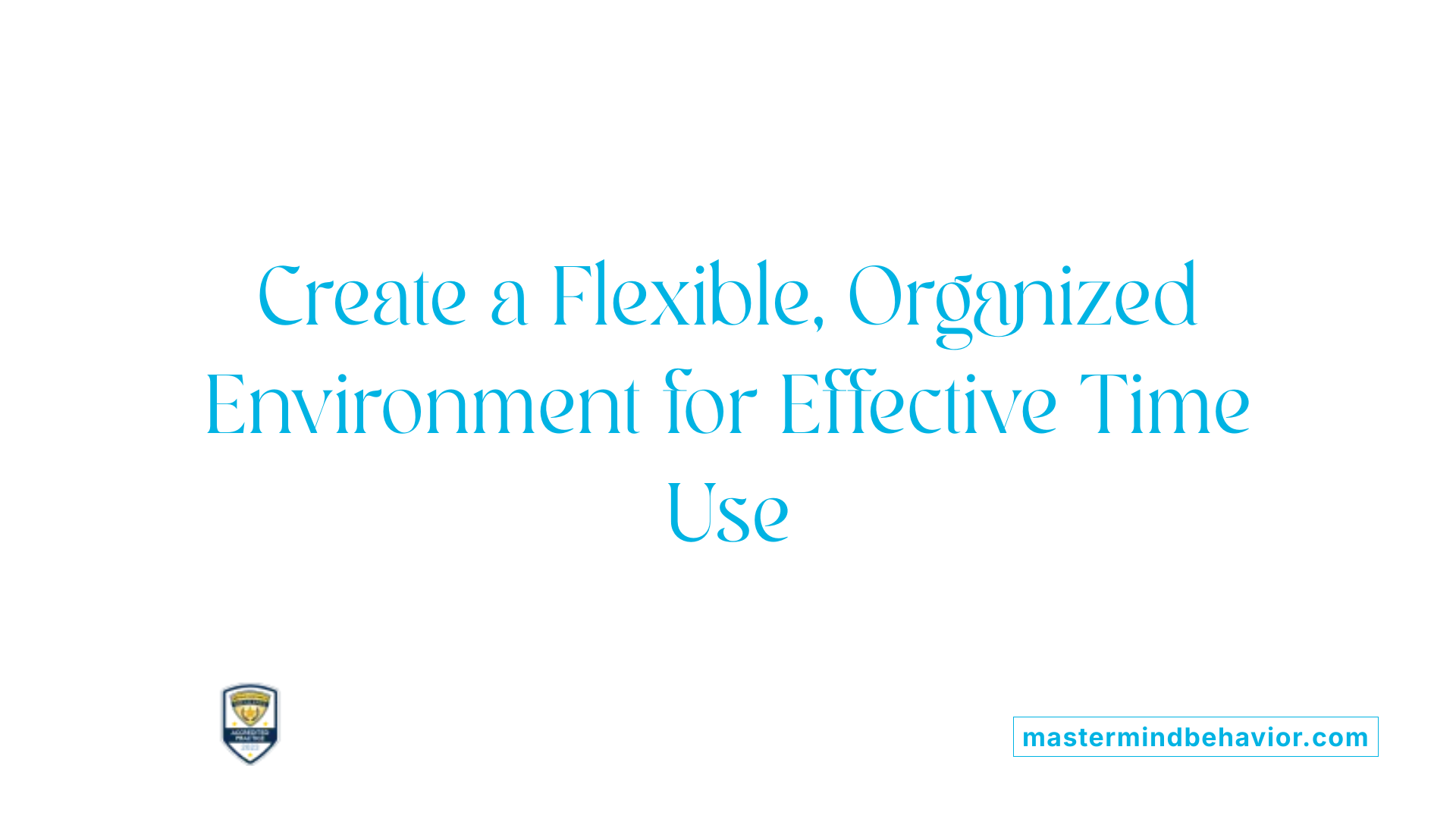Teaching Time Management Concepts Through ABA

Understanding the Intersection of ABA and Time Management
In educational settings and therapeutic practices, Applied Behavior Analysis (ABA) offers a structured, evidence-based approach to teaching complex skills such as time management. This article explores how ABA principles can be effectively utilized to help learners and educators develop time management competencies, integrating research-backed techniques, practical resources, and strategic implementation methods.
Breaking Down Time Management into Manageable Components

How can ABA be used to enhance understanding of time management concepts for learners and educators?
Applied Behavior Analysis (ABA) offers effective tools for teaching time management by simplifying complex tasks into approachable steps. By using task analysis, educators can break down routines into smaller parts, making them easier for learners to understand and master. Discrete trial training (DTT) allows for structured practice and reinforcement of each step, fostering skill development.
In natural environments, incidental teaching methods provide opportunities for learners to practice skills like punctuality and sequencing within real-life routines. Social stories and pivotal response training engage learners through play and social interactions, facilitating understanding of social cues related to time, such as arriving on time. Collaboration with caregivers and teachers ensures consistent reinforcement, supporting skill maintenance and transfer. Overall, ABA’s structured, individualized approach transforms abstract time concepts into tangible, teachable skills.
What methods can be used to implement ABA strategies for routines, task segmentation, and skill development related to time management?
Implementing ABA strategies involves detailed task analysis to dissect routines into manageable steps. Forward chaining begins with teaching the first step, gradually adding subsequent steps, while backward chaining starts from the last step, fostering a sense of accomplishment.
Prompting methods—such as visual cues, physical prompts, or verbal hints—guide learners through each activity, with prompts gradually faded to promote independence. Visual supports like daily schedules, choice boards, and visual timers help learners understand and anticipate transitions and durations. Reinforcement plays a crucial role; immediate praise or token systems motivate learners and strengthen their response to routines.
Caregiver training is essential, equipping families and educators with skills to implement these strategies consistently. Data collection during interventions helps monitor progress and adapt methods as needed, ensuring continuous improvement.
Are there educational resources available for applying ABA to improve time management?
Yes, a variety of resources support ABA-based approaches to teaching time management. Specialized training programs and curriculum guides, often offered by organizations like ABA Technologies, Inc., detail strategies such as Discrete Trial Teaching, Naturalistic Teaching, and Pivotal Response Treatment, tailored to enhance time-related skills.
Video tutorials and workshops provide practical demonstrations, helping educators and caregivers implement effective interventions. Literature such as "The Dynamic Supervisor" offers comprehensive guidance on ABA supervision and implementation. Many resources emphasize self-management strategies—like goal-setting, self-monitoring, and self-reinforcement—that empower learners to independently manage their time.
Supported by extensive research, these educational tools help ensure that ABA strategies are effectively adapted to individual needs, leading to meaningful improvements in time management.
What strategies are effective for teaching time management using ABA techniques?
Effective ABA strategies include the use of visual aids—such as schedules, timers, and clock diagrams—to concretize time concepts and aid comprehension. Breaking down telling time into smaller steps through task analysis facilitates mastery, with materials like flashcards supporting practice.
Reinforcement, immediate and consistent, motivates learners and boosts independence. Establishing routines enables learners to anticipate and prepare for transitions, reducing anxiety and confusion. Incorporating technology, such as visual schedule apps and timer alarms, enhances organization and supports executive functioning.
Using prompts initially helps learners understand expectations, gradually fading support to foster independence. These strategies create a structured learning environment that promotes generalization and real-world application of time management skills.
How can ABA principles be applied to teach time management skills?
Applying ABA principles involves analyzing routines to identify teachable components, then teaching each part step-by-step through task analysis. Reinforcements such as praise or tokens encourage timely behaviors and goal achievement.
Visual supports, including schedules, timers, and checklists, help learners understand and predict upcoming activities, fostering self-regulation. Prompting and modeling support skill acquisition, while prompt fading promotes autonomy.
Furthermore, self-management techniques like self-monitoring and setting personal goals empower learners to take responsibility for managing their time effectively. Customizing interventions based on individual profiles and incorporating naturalistic contexts ensures skills become part of everyday routines, ultimately enhancing independence in time management.
Fostering Routine Formation and Habit Development

Importance of Routines and Habits in Time Management
Developing consistent routines and habits is essential for effective time management. When students establish regular patterns for study, leisure, and daily activities, they create a structure that minimizes decision fatigue and stress. Routines help ensure important tasks are consistently prioritized, reducing the likelihood of procrastination or forgetfulness.
Having a predictable schedule allows students to allocate specific times for academic work and enjoyable activities. This balance enhances motivation and well-being, leading to a more sustainable approach to managing their responsibilities.
Building Sustainable Habits Through ABA
Applied Behavior Analysis (ABA) offers practical strategies for cultivating lasting habits. By breaking down tasks into small, achievable steps, students can gradually build routines that become automatic over time. ABA emphasizes the importance of consistent practice and positive reinforcement to strengthen desired behaviors.
For example, a student might start by dedicating five minutes daily to organizing their workspace, gradually increasing this time as it becomes habitual. The incremental approach makes habit formation less daunting and more manageable.
Role of Reinforcement in Routine Establishment
Reinforcement plays a crucial role in establishing effective routines. When students reward themselves for sticking to their schedule or completing tasks, they create positive associations that encourage continued behavior. Rewards can be small, such as taking a short break or enjoying a favorite snack.
Consistent reinforcement solidifies routines, making them more resilient to disruptions or distractions. Over time, these habits become ingrained, supporting ongoing time management success and reducing reliance on conscious effort.
| Concept | Description | Practical Example |
|---|---|---|
| Routine | Structured pattern of behavior | Setting a fixed time for studying each day |
| Habit | Automatic behavior developed through repetition | Checking a planner every morning |
| Reinforcement | Reward to strengthen behavior | Allowing leisure time after completing academic tasks |
By applying ABA principles such as breakdown of tasks, positive reinforcement, and consistent practice, students can develop sustainable routines that enhance their ability to manage time effectively and maintain overall well-being.
Incorporating Flexibility and Environmental Organization
 Flexibility is vital for effective time management because it allows students to adapt to unexpected changes and maintain a balanced routine. One helpful approach is leaving unstructured periods within the schedule, giving room to handle emergencies or spontaneous activities without stress.
Flexibility is vital for effective time management because it allows students to adapt to unexpected changes and maintain a balanced routine. One helpful approach is leaving unstructured periods within the schedule, giving room to handle emergencies or spontaneous activities without stress.
Organizing physical and social spaces also plays a significant role. Choosing quiet, distraction-free locations for studying can improve focus and efficiency. Additionally, involving friends and support networks can provide encouragement and accountability.
Creating an environment optimized for success includes not only physical space but also social support. Students can enlist friends for study groups or motivational encouragement, making it easier to stick to good habits.
By blending flexible planning with a well-structured environment, students can better manage their time, reduce frustration, and enhance overall productivity and well-being.
Using Psychological and Self-Management Strategies in Time Management

How do psychological concepts linked to stress and wellness inform effective time management?
Effective time management is not just about scheduling tasks; it is deeply connected to psychological principles that influence motivation, stress, and overall wellness. Recognizing how stress affects our ability to focus and make decisions allows students to create schedules that reduce anxiety. For example, planning realistic and attainable tasks helps avoid feelings of overwhelm, which are common sources of stress.
Moreover, incorporating enjoyable activities into the schedule can boost mood and motivation, making it easier to stay committed to academic and personal goals. Understanding the importance of routines and habits also provides stability, helping students develop consistent behaviors that support mental health.
How can self-monitoring, goal-setting, and self-reinforcement enhance time management?
Self-monitoring involves regularly assessing one's progress and effectiveness in managing time. Students are encouraged to use assessments, such as tests, to identify strengths and areas for improvement—like avoiding procrastination or handling interruptions better.
Goal-setting plays a crucial role by helping students prioritize tasks and establish clear, achievable objectives. Setting SMART goals (Specific, Measurable, Achievable, Relevant, Time-bound) guides students in creating focused schedules that align with their commitments.
Self-reinforcement involves recognizing and rewarding personal efforts. Celebrating small successes encourages persistence and boosts motivation. For example, completing a difficult task could be followed by a break or a favorite activity, reinforcing productive behaviors.
How can students enhance independence through self-management?
Developing self-management skills fosters independence by empowering students to take control of their schedules and routines. When students learn to organize their environments—such as choosing quiet study spots or enlisting friends for accountability—they build habits that support autonomous decision-making.
By thoughtfully responding to interruptions or impulses rather than reacting impulsively, students develop resilience and better focus. This proactive approach encourages a sense of mastery and confidence in managing their time.
Overall, integrating psychological concepts with practical strategies helps students build sustainable habits, manage stress better, and achieve personal success in their academic and social lives. The use of regular assessments and adjustments ensures continuous growth and improved self-direction.
Empowering Learners and Educators for Time Management Success
Integrating ABA principles into time management education offers a comprehensive, adaptable, and effective approach to fostering independence and organizational skills. By breaking down routines, utilizing visual supports, and emphasizing reinforcement, educators and learners can develop sustainable habits, adapt to changes, and build resilience in managing daily tasks. The combination of structured behavioral strategies and psychological insights creates a powerful toolkit, ensuring that individuals are equipped to succeed academically, socially, and personally in their time management endeavors.
References
- Principles of Effective Time Management for Balance, Well ...
- Time Management Activity
- Establishing a Home-Based ABA Therapy Routine for Early ...
- ABA Therapy Goals: 25 Practical Examples & Timelines
- Visual Supports for Students with Autism in the Classroom
- Fun and Productive Activities for ABA Therapy
- How ABA Therapy Helps Build Daily Living Skills for Autism
- Time Management and Supervision with Dr. Breanne Hartley
Recent articles

How ABA Therapy Helps Build Healthy Daily Habits
Building Healthy Habits with Evidence-Based Strategies

The Role Of ABA Therapy In Building Flexible Thinking Skills
Unlocking Cognitive Flexibility Through ABA Interventions

ABA Therapy For Building Positive Self-Image In Children
Transforming Self-Perception Through Evidence-Based Interventions

How ABA Therapy Supports Adolescents In Social Problem Solving
Empowering Teens Through Evidence-Based Social Skills Development

How ABA Therapy Encourages Verbal Problem-Solving Responses
Unlocking Communication Potential in Children with ABA

Using ABA Therapy To Build On-task Behavior In Classrooms
Transforming Classroom Engagement with ABA Principles



